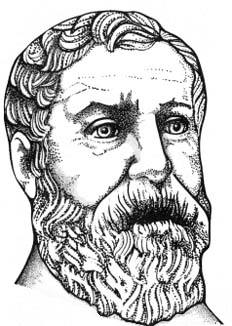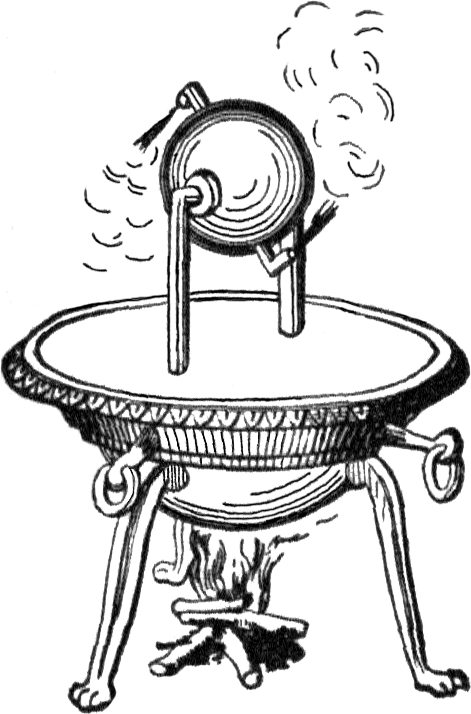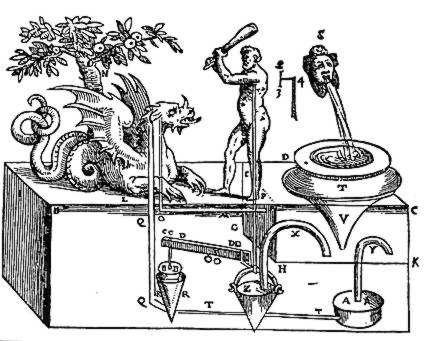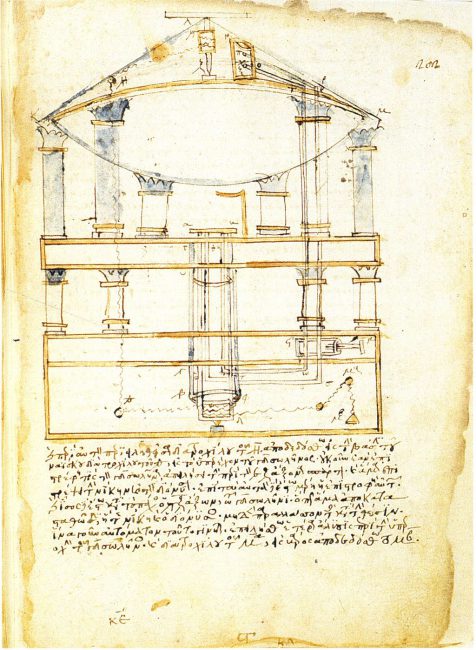
Hero of Alexandria (1st century CE, from an illustration of the 17th century edition of his Pneumatica)
Hero of Alexandria was a Greek mathematician and engineer who was active in his native city of Alexandria, Roman Egypt in the first century AD. He is considered the greatest experimenter of antiquity. Among his most famous inventions was a windwheel, constituting the earliest instance of wind harnessing on land, as well as the well recognized description of a steam-powered device called an aeolipile.
The Problem with the Date
A major difficulty regarding Hero was to establish the date at which he lived. There were two main schools of thought on this, one believing that he lived around 150 BC and the second believing that he lived around 250 AD. However, both have been proven wrong, since in the early 20th century it was discovered that Hero in one of his writings referred to a recent eclipse which, from the information given by Hero, took place in Alexandria at 23.00 hours on 13 March 62 AD. From Hero‘s writings it is reasonable to deduce that he taught at the Museum in Alexandria, which included the famous Library of Alexandria,. His works look like lecture notes from courses he must have given there on mathematics, physics, pneumatics, and mechanics. Some are clearly textbooks while others are perhaps drafts of lecture notes not yet worked into final form for a student textbook.[1] Actually, nothing is really known of Hero‘s life, but what we do know comes from clues in the 14 known books by him.
Hero’s Most Famous Book
One of his books, Metrica, was lost until the end of the 19th century. Scholars knew of its existence only through one of his other books. In 1894, historian Paul Tannery discovered a fragment of the book in Paris. Then, in 1896, Robin Schone found a complete copy in Constantinople. This book is the most famous book that Hero wrote. It consists of 3 volumes, and shows ways to calculate area and volume, and their divisions.

Hero’s Aeolipile Engine
Hero’s Inventions
But, besides his mathematical writings, Hero is best known for his invention of automated devices in particular. Hero described the construction of the aeolipile (a version of which is known as Hero‘s engine) which was a rocket-like reaction engine and the first-recorded steam engine (although Vitruvius already mentioned the aeolipile in De Architectura some 100 years earlier than Hero).
The aeolipile was a hollow sphere mounted so that it could turn on a pair of hollow tubes that provided steam to the sphere from a cauldron. The steam escaped from the sphere from one or more bent tubes projecting from its equator, causing the sphere to revolve. The aeolipile is the first known device to transform steam into rotary motion. [3]
Both Hero and Vitruvius draw on the much earlier work by Greek inventor and mathematician Ctesibius (285–222 BC), who wrote the first treatises on the science of compressed air and its uses in pumps. However, Hero‘s aeolipile was created almost two millennia before the industrial revolution. Another engine used air from a closed chamber heated by an altar fire to displace water from a sealed vessel. The water was collected and its weight, pulling on a rope, opened temple doors. Both inventions are described in Hero‘s book Pneumatica, in which he presented overallaround 80 mechanical apparatus, that work with air, steam or hydraulic pressure.

Reconstruction of one of many “automata” of Heron by Giovanni Battista Aleoti 1589. Hercules and the Dragon. When Hercules hits the head of the dragon the dragon shoots water on his face.
An Antique Greek Vending Machine
Hero also described the first vending machine as being one of his construction. When a coin was introduced via a slot on the top of the machine, a set amount of holy water was dispensed, as described in his list of inventions in his book Mechanica. When the coin was deposited, it fell upon a pan attached to a lever. The lever opened up a valve which let some water flow out. The pan continued to tilt with the weight of the coin until it fell off, at which point a counter-weight would snap the lever back up and turn off the valve.
Theatre Inventions
Hero also invented many mechanisms for the Greek theater, including an entirely mechanical play almost ten minutes in length, powered by a binary-like system of ropes, knots, and simple machines operated by a rotating cylindrical cogwheel. The sound of thunder was produced by the mechanically-timed dropping of metal balls onto a hidden drum.

Hero of Alexandria, Automata 13: Sketch of an automaton, a wine and milk dispensing Bacchus figure in a small temple. The figure is connected by invisible tubes to hidden wine and milk containers, which allow wine and milk to flow into the thyrsos rod through the opening of valves. The drawing shows the vascular chambers, pipes and valves. Venice, Biblioteca Nazionale Marciana,
Measuring Instruments
In his book Dioptra, Hero gives extensive explanations about the practical and mathematical methods for land surveying. It also included information about the Dioptra, which was the forerunner of the modern theodolite. It allowed surveyors to calculate angles and heights with great precision. The text also described the odometer, used for calculating distances via the rotation of a wheel of known circumference. the odometer was a chariot with wheels of 4 feet diameter, which turned exactly 400 times in one Roman mile. For each revolution, a pin on the axle engage a 400 tooth cogwheel, thus making one complete revolution per mile. This engages another gear with holes along the circumference, where pebbles (calculi) are located that drop one by one into a box. The number of miles travelled is given simply by counting the number of pebbles. Leonardo da Vinci tried to build it according to Hero‘s description, but failed.[4]
Optics
In Optics, Hero formulated the Principle of the Shortest Path of Light: If a ray of light propagates from point A to point B within the same medium, the path-length followed is the shortest possible. It was nearly 1000 years later that Arabic scholar Alhacen expanded the principle to both reflection and refraction, and the principle was later stated in this form by Pierre de Fermat in 1662
Programmable “Computers”
In Automatopoietca, Hero included his designs for automatic machines, many of which were programmable computers using gears and knotted ropes. It could be argued that they were the first robots using simple binary language. There, he also described a programmable cart that was powered by a falling weight, while “program” consisted of strings wrapped around the drive axle. In Belopoiica (On Engines of War), Hero gave explanations and diagrams of various weapons of war, including a crossbow known as the Gastraphetes and various other artillery engines.
In Metrica, Hero describes (and proofs) how to calculate the area under a triangle, a method which is known today as Hero’s formula. It has been suggested that Archimedes knew the formula over two centuries earlier, and since Metrica is a collection of the mathematical knowledge available in the ancient world, it is possible that the formula predates the reference given in that work.
Hero of Alexandria Changed the World with this Invention Much Earlier than Many Thought, [10]
References and Further Reading:
- [1] O’Connor, John J.; Robertson, Edmund F., “Hero of Alexandria“, MacTutor History of Mathematics archive, University of St Andrews.
- [2] “Hero of Alexandria.” Complete Dictionary of Scientific Biography. 2008. Encyclopedia.com
- [3] Hero of Alexandria in the 1911 Encyclopædia Britannica
- [4] Michael Lahanas: Hero of Alexandria, at HellenicaWorld
- [5] Thomas Newcomen and the Steam Engine, SciHi Blog
- [6] Leonardo Da Vinci – the Prototype of a Renaissance Man, SciHi Blog
- [7] Pierre de Fermat and his Last Problem, SciHi Blog
- [8] Hero of Alexandria at Wikidata
- [9] . New International Encyclopedia. 1905.
- [10] Hero of Alexandria Changed the World with this Invention Much Earlier than Many Thought, Deep History @ youtube
- [11] Timeline of Antique Greek Scientists, via DBpedia and Wikidata





